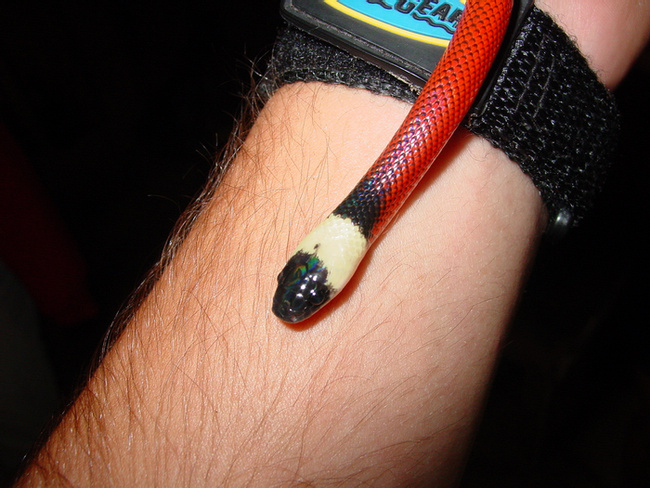
More about Zopilota
Habitat
This snake is common among lowland habitats including disturbed zones, secondary forest, dry, moist, and wet forest. It may be found in adjacent premontane moist forest.
Range
Clelia clelia lives on the Pacific slope from southern Mexico to Argentina, and on the Atlantic slope from Guatemala to Argentina.
Physical Description
An important snake, the zopilota looks like a different species when it is young. Juveniles have a solid red body and tail with a pale collar beneath the black head. With this brighter coloration some people expect them to be poisonous, so the juvenile has acquired the extra nickname of Vibora de Sangre (“Blood Snake”). These become large, grey to bluish black adults with black eyes, a pale underside, and scattered darker areas where the underside meets the upper coloration.
Biology and Natural History
This strong, large snake is not feared among Costa Ricans—in fact, it is appreciated. The zopilota eats other snakes, including dangerous pit vipers. The potent fer-de-lance (Bothrops asper) is an ordinary food item for the zopilota, who apparently is immune to the venom of other snakes.
Employing an unusual, combined strategy, this animal attacks prey using both venom and constriction. Its grooved fangs are in the back of its mouth and the venom does not act quickly, so the zopilota will hold its prey behind the head and while it injects venom into the neck, also coils its body around the other snake. The prey is immobilized by the venom but actually killed by constriction. The zopilota has probably evolved to use both tactics because other strong, large snakes are difficult to grasp while venom runs its course.
Clelia clelia has venom and behavior not well-suited to posing a threat to humans. This snake tends to calm down while it is held and rarely tries to strike in self-defense. Even if it were aggressive, with rear fangs it would be difficult for the zopilota to inject venom without taking a little time to chew.
This snake is common on the forest floors in Costa Rica and hunts for other snakes during the night. Occasionally it is also active during the day.
Diet
Sometimes breaking pattern to eat lizards or mammals, the zopilota usually eats other snake species. Atropoides, Bothrops, Crotalus, and Porthidium are common victims.
Height/Weight
This large snake can reach a total length of 2.6 m. Females are longer than males.
Taxonomy
Order: Squamata
Family: Colubridae
Sources
Leenders, Twan. A Guide to Amphibians and Reptiles of Costa Rica. Zona Tropical, S.A, Miami, FL, 2001.
Savage, Jay M. The Amphibians and Reptiles of Costa Rica: A Herpetofauna between two Continents, between Two Seas. The University of Chicago Press, Chicago, 2002.
Savage, J. M., N. J. Scott, and D. C. Robinson in: Janzen, Daniel H. Costa Rican Natural History. Chicago: University of Chicago Press, 1983.
Scott, N. J. in: Janzen, Daniel H. Costa Rican Natural History. Chicago: University of Chicago Press, 1983.
-Amy Strieter, Wildlife Writer
Zopilota Sightings
Similar Profiles
We believe travel is more than ticking destinations off a list – it’s about discovering new places deeply, feeling connected wherever you go, and knowing you have a trusted team behind you every step of the way.



